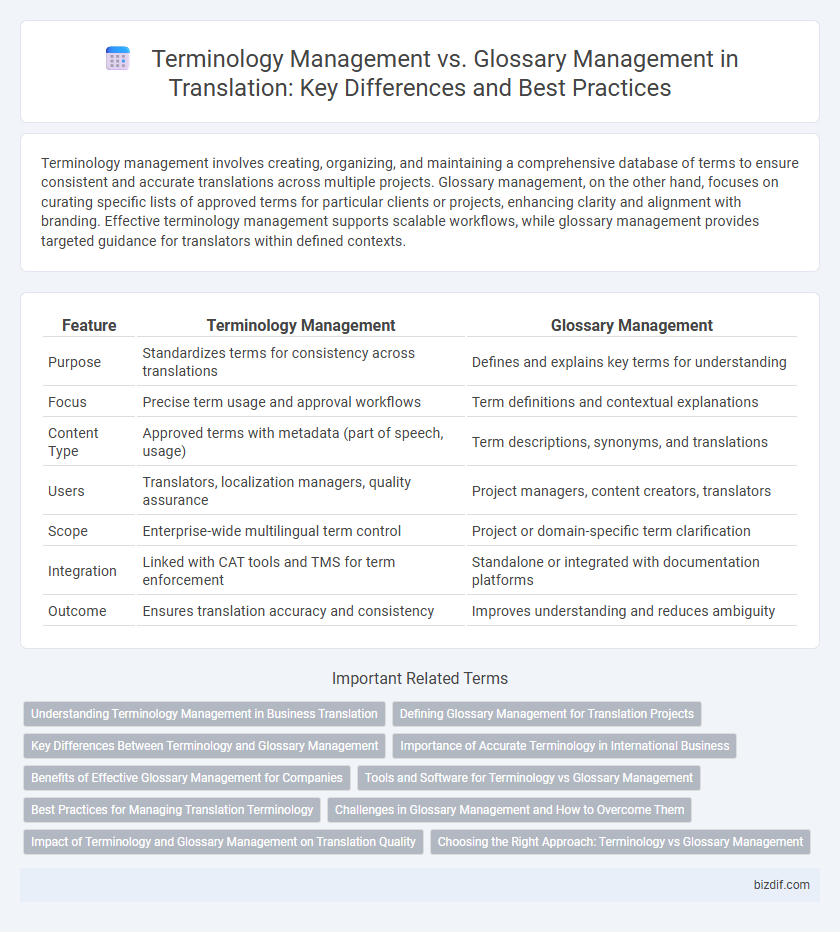Terminology management involves creating, organizing, and maintaining a comprehensive database of terms to ensure consistent and accurate translations across multiple projects. Glossary management, on the other hand, focuses on curating specific lists of approved terms for particular clients or projects, enhancing clarity and alignment with branding. Effective terminology management supports scalable workflows, while glossary management provides targeted guidance for translators within defined contexts.
Table of Comparison
| Feature | Terminology Management | Glossary Management |
|---|---|---|
| Purpose | Standardizes terms for consistency across translations | Defines and explains key terms for understanding |
| Focus | Precise term usage and approval workflows | Term definitions and contextual explanations |
| Content Type | Approved terms with metadata (part of speech, usage) | Term descriptions, synonyms, and translations |
| Users | Translators, localization managers, quality assurance | Project managers, content creators, translators |
| Scope | Enterprise-wide multilingual term control | Project or domain-specific term clarification |
| Integration | Linked with CAT tools and TMS for term enforcement | Standalone or integrated with documentation platforms |
| Outcome | Ensures translation accuracy and consistency | Improves understanding and reduces ambiguity |
Understanding Terminology Management in Business Translation
Terminology management in business translation involves systematically organizing and maintaining consistent use of specialized terms across all translated materials, ensuring brand consistency and clear communication. It encompasses creating multilingual term databases that support translators and streamline workflows, reducing errors and saving time. Glossary management, while related, typically refers to maintaining a simpler list of key terms without the integrated processes and tools that comprehensive terminology management requires.
Defining Glossary Management for Translation Projects
Glossary management for translation projects involves the systematic creation, organization, and maintenance of a curated list of terms specific to a brand, industry, or client to ensure linguistic consistency and accuracy across all translated content. It encompasses defining preferred translations, usage notes, and context-specific guidelines to facilitate clear communication between translators and stakeholders. Effective glossary management reduces ambiguity, accelerates translation workflows, and enhances quality assurance in multilingual projects.
Key Differences Between Terminology and Glossary Management
Terminology management involves the systematic collection, organization, and standardization of specialized terms across a domain to ensure consistency in translation and communication. Glossary management focuses on maintaining a curated list of terms with definitions and usage notes, primarily serving as a reference tool for translators and subject matter experts. The key differences lie in terminology management's emphasis on term lifecycle, accuracy, and standardization, while glossary management prioritizes accessibility and clarity of individual entries.
Importance of Accurate Terminology in International Business
Accurate terminology management ensures precise and consistent use of specialized terms across multilingual content, reducing misunderstandings and enhancing brand integrity in international business. Glossary management supports this by providing clear definitions and standardized word choices that facilitate effective communication among global partners and customers. Efficient terminology systems improve translation quality, accelerate localization workflows, and strengthen competitive advantage in diverse markets.
Benefits of Effective Glossary Management for Companies
Effective glossary management ensures consistent use of terms across all company communications, enhancing brand clarity and customer trust. It streamlines translation workflows by providing translators with clear, standardized references, reducing errors and improving efficiency. Comprehensive glossaries facilitate knowledge retention and onboarding, supporting regulatory compliance and multilingual content accuracy.
Tools and Software for Terminology vs Glossary Management
Terminology management tools, such as SDL MultiTerm and MemoQ, are designed to handle complex term bases with advanced features like term extraction, approval workflows, and integration with CAT tools, ensuring consistent usage across large translation projects. Glossary management software, including tools like Smartcat and Across, offers simpler interfaces focused on creating and sharing curated lists of approved terms, often used for smaller projects or quick reference. Effective translation workflows typically combine both types of software to balance detailed term control with accessible glossary references, optimizing overall linguistic consistency and productivity.
Best Practices for Managing Translation Terminology
Effective terminology management involves systematically organizing and updating terms within a centralized database to ensure consistency across all translation projects. Glossary management focuses on maintaining a curated list of approved terms with definitions, often tailored for specific clients or industries, facilitating quick reference and uniform usage. Incorporating both practices enhances translation quality by reducing errors, streamlining communication, and supporting scalable multilingual workflows.
Challenges in Glossary Management and How to Overcome Them
Glossary management faces challenges such as inconsistent term definitions, frequent updates, and lack of user engagement, which can lead to confusion and inefficiencies in translation projects. Implementing centralized terminology databases, regular stakeholder reviews, and integrating glossary tools with CAT software enhances accuracy and consistency. Overcoming these obstacles ensures coherent terminology usage, improving translation quality and reducing project turnaround times.
Impact of Terminology and Glossary Management on Translation Quality
Effective terminology management ensures consistent use of industry-specific terms across all translated materials, significantly enhancing translation accuracy and coherence. Glossary management supports translators by providing clear definitions and context, reducing ambiguity and improving linguistic precision. Together, these practices minimize errors, streamline localization workflows, and elevate overall translation quality by maintaining uniformity and clarity.
Choosing the Right Approach: Terminology vs Glossary Management
Terminology management involves systematically standardizing and controlling multilingual terms to ensure consistency and accuracy across all translation projects, while glossary management focuses on creating and maintaining a curated list of key terms specific to a project or client. Choosing the right approach depends on project scale and complexity; extensive, ongoing projects benefit from comprehensive terminology management systems, whereas smaller or one-off projects may be best served by a focused glossary. Effective terminology management enhances translation quality, reduces localization costs, and streamlines workflows by integrating with translation memory tools.
Terminology Management vs Glossary Management Infographic

 bizdif.com
bizdif.com